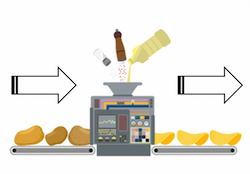What are directly attributable costs?
Last update: 2023
When you acquire a long-term asset, you can include directly attributable costs to the initial measurement of its cost.
Although IFRS define directly attributable expenses quite clearly and provide a few examples, there are many different items we are not sure about.
In this article, I decided to look at directly attributable expenses with a magnifier and to give you some guidance for your future use.
I’d like to focus on acquisition of tangible assets under IAS 16 Property, Plant and Equipment, but the same principles apply for intangibles and other assets, too.
What do the rules say?
IAS 16 says that we can capitalize any costs directly attributable to bringing the asset to the location and condition necessary for it to be capable of operating in the manner intended by management (IAS 16.16(b)).
In the paragraph 17 of IAS 16 there are the examples of what expenses are considered to be directly attributable and therefore, can be capitalized (or included in the cost of an asset):
- Costs of employee benefits (IAS 19 Employee benefits) arising directly from the construction or the acquisition of the item of PPE,
- Costs of site preparation,
- Initial delivery and handling costs,
- Installation and assembly costs,
- Costs of testing whether the asset is functioning properly, after deducting the net proceeds from selling any items produced while bringing the asset to that location and condition, and
- Professional fees.
As opposed to that, the paragraph 19 of IAS 16 lists examples of costs that are not costs of an item of PPE and therefore, cannot be capitalized:
- Costs of opening a new facility
- Costs of introducing a new product or service
- Costs of conducting a business in a new location or with a new class of customer, and
- Administration and other general overhead costs.
On top of that, IAS 16 clarifies in the paragraph 20 that costs of operation below full capacity, initial operating losses and relocating or reorganizing entity’s operations are not to be capitalized.
Clear enough.
Yet in practice, there are many items that require our careful judgment and we are not sure whether to include them in the cost of an asset or not. These doubts arise especially when your company constructs a big asset, such as a plant or a mine.
Let’s break it down.
Cost of employee benefits

Here, two principal questions arise:
- Which employee categories arise from the construction or the acquisition of the asset?
The answer is no admin, no general functions, no research activities, no marketing & advertising, no training employees.
It means that:
- You can capitalize the employee benefits provided to site workers, in-house architects and surveyors or production supervisors. To some extent, you can also capitalize quality controls and testing (if these activities are inevitable in order to put an asset into use).
- You cannot capitalize any portion of employees benefits paid to general managers, accountants taking care solely about ship’s accounting, etc.
- Which expenses related to these employees can be capitalized?
The answer is all employee benefits under IAS 19 and that is:
- Short-term employee benefits (salaries, wages, paid vacation…)
- Post-employment benefits
- Other long-term benefits and
- Termination benefits.
The following types of expenses are NOT employee benefits under IAS 19 and therefore, they shall be considered separately:
- Travel expenses of your employees,
- Training of your employees,
How should you include the expenses for the employee benefits into the cost of your asset?
The answer is based on some reasonable allocation method.
For example, you build a ship. Based on timesheet reports you find out that in 20X1 John worked:
- 1 500 hours on the ship construction,
- 300 hours on other projects or work, and
- he took 100 hours of paid vacation.
Your company incurred the following expenses for employee benefits in relation to John’s work:
- Salary: CU 18 000
- Compensation for paid vacation (in line with law): CU 1 000
- Expense for contribution into a pension fund (defined contribution plan): CU 2 000
How much of these benefits can you include into a cost of a ship?
You can include all of these expenses for employee benefits allocated on a reasonable basis.
In this case, we can allocate it based on time spent on a ship construction (1 500 hours) and total time worked (1 500+300=1 800 hours).
Here, we do not take the paid vacation time into account for allocation purposes. It means that a compensation for paid vacation will be allocated to the cost of a ship. The reason is that a company is obliged to provide this vacation to its employees and a vacation is simply another cost of worked hours.
The calculation:
- Allocation of salary: CU 18 000*1 500/1 800 = CU 15 000
- Compensation for paid vacation: CU 1 000*1 500/1 800 = CU 833
- Contribution to a pension fund: CU 2 000*1 500/ 1 800 = CU 1 667
- TOTAL: CU 17 500
Note: you include only current year’s expenses; or the expenses incurred during ship’s construction.
Cost of relocating the asset to the new location

Can you capitalize these expenses to the cost of a machine?
In short, no – this is a relocation cost and IAS 16 specifically says it cannot be capitalized, but expensed as incurred.
Insurance of an asset

The reason is that these costs are not inevitable to bring the assets to the condition and location to operate as desired by the management.
In fact, these costs are incurred to protect an asset against some risks during some period and therefore, it would not be correct to take these costs to the cost of an asset and put them in profit or loss via depreciation over asset’s useful life.
Some time ago, one CFO raised a point to this matter. He said:
“We take a loan to finance the acquisition of a plant, but our bank insists on insurance policy for this plant. Otherwise we won’t get a loan. Without an insurance policy we cannot acquire a plant, therefore I think the insurance cost can be capitalized as it’s inevitable”.
Hmmm, a good argument, but the truth is that the CFO needed an insurance policy to get a loan and not to acquire an asset. In other words, that company could have acquired a plant without a loan, with a cash payment and in such a case, no insurance policy would be necessary.
Operating lease expenses for land

Can you capitalize these expenses?
This question is quite controversial and really, an answer depends on how well you can justify your own view in front of your auditors.
I’d like to give you arguments for YES and NO here:
YES, capitalize:
Operating lease charges can be considered directly attributable costs and included into cost of an item of PPE, if these lease costs are necessary to bring the asset to the desired condition and location. Therefore, rentals paid for land under operating lease on which you build a building can be capitalized into a cost of a building during a construction stage.
NO, don’t capitalize:
I am more in favor of no capitalization, but recognizing these expenses in profit or loss.
The reason is that it produces quite inconsistent impact on profit or loss. If you include just rentals during the construction period into the cost of PPE and you expense the subsequent rentals as they incur, then the first rentals will be expensed via depreciation over asset’s useful life, and the remaining rentals will be expensed immediately. This means that matching principle is shattered.
Also, I always see a land as a separate asset, because its useful life is different from the life of a building on it. The rental payments relate to the “acquisition of a land”, not to a building itself.
You can read more about it here.
Anyway, this is one of the reasons why I like the new IFRS 16 Leases. Under the new standard, you will have to recognize a right-to-use asset instead of dealing with operating lease payments and therefore, this dilemma will not exist anymore.
Travel expenditures

Or, can you capitalize travel expenses of a consultant who came to your site to perform professional work related to PPE?
Unless you have a great argumentation ready for your auditor, then no, you should not do it.
The reason is that these expenses relate more to personal services than to bring an asset to the desired location and condition. At least, that’s what I experienced in the practice.
However, this area is quite unclear and you might be successful to provide good arguments to your auditor for capitalizing.
If you hire a consultant and you agree to pay travel cost for him, you should try to negotiate the higher price for his services with inclusion of all his expenses (to hide his travel expenses into the cost of service) – just to be on a safe side.
Other expenses you CAN capitalize
- Fees for environmental permits, certifications whether an asset works properly
- Expenses for necessary repairs during the construction phase
- Expenses for removing hurdles on the site (e.g. demolition of old building)
Do not capitalize:
- Training expenses (never!)
- Expenses for searching an appropriate site, evaluation of a site, feasibility study
- Advertising and marketing expenses
- Expenses to hire employees
OK, guys, I’ve just tried to bring more light to the most common types of expenses and feel free to ask in the comments if you need help with something else. I might update this article and add some more explanations!
Tags In
JOIN OUR FREE NEWSLETTER AND GET
report "Top 7 IFRS Mistakes" + free IFRS mini-course
Please check your inbox to confirm your subscription.
Recent Comments
- Albert on Accounting for gain or loss on sale of shares classified at FVOCI
- Chris Kechagias on IFRS S1: What, How, Where, How much it costs
- atik on How to calculate deferred tax with step-by-step example (IAS 12)
- Stan on IFRS 9 Hedge accounting example: why and how to do it
- BSA on Change in the reporting period and comparatives
Categories
- Accounting Policies and Estimates (14)
- Consolidation and Groups (25)
- Current Assets (21)
- Financial Instruments (56)
- Financial Statements (54)
- Foreign Currency (9)
- IFRS Videos (74)
- Insurance (3)
- Most popular (7)
- Non-current Assets (56)
- Other Topics (15)
- Provisions and Other Liabilities (46)
- Revenue Recognition (27)
- Uncategorized (1)





We have paid for appeasing chiefs for stability of the community so the project can go ahead, can we capitalize the cost paid to the chiefs?
We have incurred considerable legal expenses to remove illegal squatters from a piece of land we own in order for us to build a shopping centre on the land. Can these costs be capitalised?
Fantastic question! Yes, you can – the cost of removal of the obstacle on the land is directly attributable to the development on that land. I will share this on my social networks, too – thank you!
Dear Silvia,
Good day!
I have one issue to discuss about directly attributable cost. Let’s say, a company has a compensation Manager under HR and a Account Manager . Currently they are devoting a significant time for resource planning by Compensation Manager and solving finance related issues (i.e., negotiation with the contractor about rates & fees and fixing agreements, coordinating the payments etc.) by Account Manager of a new ongoing project. Have not the project started, they could devote their time in other regular activities. Can the salary cost of the above employees be allocated to the project on a reasonable basis? If not, please help me to understand the reasons as per IAS 16.
Thanks in advance.
No, the salary costs cannot be allocated to the project under IAS 16 because they are indirect administrative costs. Their roles in HR and finance (e.g., resource planning, negotiations, and payments) do not directly contribute to the construction or acquisition of the asset, making them ineligible for capitalization.
Dear Silvia,
Hope you are doing fine!
We got Project Management Office (PMO) at our company which are engaged in managing the different company projects i.e., building/plant/factory construction. I would like to know how the employee costs of the Project Management Office can be distribute on reasonable basis among the projects? Is it feasible to use project budgets or CWIP costs to allocate the cost? Please let me know.
Hi Aminur, yes,you can capitalize PMO employee costs if they’re directly attributable and allocated in a systematic, reliable way. You can use time-based or budget/CWIP-based methods, provided they’re fair, consistently applied, and reflect actual project effort.
Dear Silvia,
Much appreciated! Take care.
Hi I have a question, if a Fire Engineer gets appointed to conduct a fire plan for the site that will determine the risk, propose solutions and provide budget figures for future implementation. And these costs are over 100k, would one be able to capitalise this ?
I think so – as I guess this risk assessment is absolutely necessary in order to work on the development of the site.
Hey… A quick question. I understand insurance premiums are not capitalised on the cost of the asset. After a claim is made and the excess payment paid. Can the excess payment be capitalized on the cost of the asset?
Dear Silvia,
we paid land development fees to the city, which will be reimbursed in case we fulfill the requirements. It is almost certain we will fulfill the requirements as of now. How these land development fees should be treated? We added them to the value of land initially. Thanks
Hi Developer,
just deduct them from the cost of land, since it is where you reported them and they do not represent the revenue or income; rather they are a sort of a discount on costs you incurred.
Are you able to provide me more explanation as to why? Is it because revenue is considered an indirect cost?
Why what? Could you specify? Also, I don’t quite understand what you mean by “revenue is considered an indirect cost”… revenue and costs are two fundamentally different concepts.
I have an capital project X1. It requires a current plant x2 to be down for a period of time to upgrade machinery connecting both plants. Can the lost revenue on X2 plant be capitalised to X1 capital project?
The short answer is no.